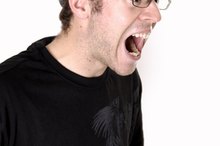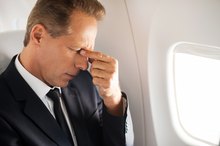Post-Run Head & Nose Pain
Running is a moderate- to high-intensity activity that requires many systems in the body to work overtime to support the extra energy expenditure. Although this level of exercise has been proven to be better for you than no exercise at all, it may sometimes cause discomfort. Mild pain in the head and the nose after running usually is not a serious condition, but as with any pain in the body, it is best to seek the advice of a medical professional.
If you are experiencing serious medical symptoms, seek emergency treatment immediately.
Exercise Physiology
During moderate to intense exercise, such as running, more demands are placed on the systems of the body. The respiratory system works harder to deliver more oxygen to the blood, and the heart pumps faster to deliver fresh oxygen to the muscles. Even the digestive system participates by slowing down to conserve energy needed by the muscles. As a result, it's not uncommon to feel aches, pains and discomfort in many areas of the body during exercise on a frequent or infrequent basis. However, any pain that is recurring should be checked by your health care professional, as it can be a sign of an underlying illness.
- During moderate to intense exercise, such as running, more demands are placed on the systems of the body.
Sinus Pressure
Is Sinus Trouble Connected to Weather?
Learn More
Whenever there is pain in the head and nose, the sinuses are a likely culprit. Sinuses are air-filled spaces in your head that connect to your nasal passages and serve several purposes, including warming the air you inhale, insulating the eyes and nerves, improving voice resonance and protecting the face from trauma. Sinuses can become infected, causing a build-up of pus and pain and pressure in the head and nose. Symptoms of sinus infection may be mild or severe. Some people suffer from chronic sinus infections, which may be worsened by running. If you think sinus pressure may be the cause of your pain after running, see your doctor for a diagnosis and treatment plan.
- Whenever there is pain in the head and nose, the sinuses are a likely culprit.
- Sinuses can become infected, causing a build-up of pus and pain and pressure in the head and nose.
Cold Weather
Running in cold weather can be uncomfortable. Breathing in icy air may cause pain in sensitive nasal passages in some people. Cold air also is drier, which cause sinuses to dry out, bringing on sinus pain and pressure, headache and pain in the nasal area. If your head and nose hurt only when running in cold weather, take precautions to protect yourself from the elements -- wear a hat to trap body heat and, if temperatures are very cold, consider wearing a a protective layer over your mouth and nose to avoid breathing in icy cold air 4. At home, keep a humidifier running to add moisture to the air, which will help keep your sinuses healthy, even when you're not out on the trail.
- Running in cold weather can be uncomfortable.
- Cold air also is drier, which cause sinuses to dry out, bringing on sinus pain and pressure, headache and pain in the nasal area.
Other Causes
Pain in the Base of the Head During Exercise
Learn More
Other causes of pain in the head and nose while running may include chronic migraines, dehydration, fatigue, high blood pressure or other underlying conditions. Most mild headaches after running are not serious and are a result of the dilation of blood vessels inside the skull. However, more severe headaches and pains, or those accompanied by nausea, vomiting or blurred vision, should be checked by a doctor, as they can be a sign of a serious condition.
Related Articles
References
- Harvard Men's Health Watch: Headache: When to Worry, What to Do
- Sports Medicine: The Effect of Exercise on the Gastrointestinal Tract
- University of Maryland Medical Center: Sinus Headache
- Lopes AD, Costa LO, Saragiotto BT, Yamato TP, Adami F, Verhagen E. Musculoskeletal pain is prevalent among recreational runners who are about to compete: an observational study of 1049 runners. J Physiother. 2011;57(3):179-82. doi:10.1016/S1836-9553(11)70039-X
- Bonasia DE, Rosso F, Cottino U, Rossi R. Exercise-induced leg pain. Asia Pac J Sports Med Arthrosc Rehabil Technol. 2015;2(3):73-84. doi:10.1016/j.asmart.2015.03.003
- Wilcox CE, Mayer AR, Teshiba TM, et al. The subjective experience of pain: An FMRI study of percept-related models and functional connectivity. Pain Med. 2015;16(11):2121-33. doi:10.1111/pme.12785
- Hullfish TJ, Hagan KL, Casey E, Baxter JR. Achilles tendon structure differs between competitive distance runners and nonrunners despite no clinical signs or symptoms of midsubstance tendinopathy. J Appl Physiol. 2018;125(2):453-458. doi:10.1152/japplphysiol.00012.2018
- Linton L, Valentin S. Running with injury: A study of UK novice and recreational runners and factors associated with running related injury. J Sci Med Sport. 2018;21(12):1221-1225. doi:10.1016/j.jsams.2018.05.021
- Davis IS, Futrell E. Gait retraining: Altering the fingerprint of gait. Phys Med Rehabil Clin N Am. 2016;27(1):339-55. doi:10.1016/j.pmr.2015.09.002
- Gallo RA, Plakke M, Silvis ML. Common leg injuries of long-distance runners: anatomical and biomechanical approach. Sports Health. 2012;4(6):485-95. doi:10.1177/1941738112445871
- Quah JL, Yap S, Cheah SO, et al. Knowledge of signs and symptoms of heart attack and stroke among Singapore residents. Biomed Res Int. 2014;2014:572425. doi:10.1155/2014/572425
- Nichols AW. Heat-related illness in sports and exercise. Curr Rev Musculoskelet Med. 2014;7(4):355-65. doi:10.1007/s12178-014-9240-0
- Chang WD, Lin HY, Lai PT. Core strength training for patients with chronic low back pain. J Phys Ther Sci. 2015;27(3):619-22. doi:10.1589/jpts.27.619
- Kunene SH, Ramklass S, Taukobong NP. Anterior knee pain and its intrinsic risk factors among runners in under-resourced communities in Ekurhuleni, Gauteng. S Afr J Physiother. 2018;74(1):452. doi:10.4102/sajp.v74i1.452
- Brewer RB, Gregory AJ. Chronic lower leg pain in athletes: a guide for the differential diagnosis, evaluation, and treatment. Sports Health. 2012;4(2):121-7. doi:10.1177/1941738111426115
- Mellinger S, Neurohr GA. Evidence based treatment options for common knee injuries in runners. Ann Transl Med. 2019;7(Suppl 7):S249. doi:10.21037/atm.2019.04.08
- Hatzigeorgiadis A, Zourbanos N, Galanis E, Theodorakis Y. Self-talk and sports performance: A meta-analysis. Perspect Psychol Sci. 2011;6(4):348-56. doi:10.1177/1745691611413136
Writer Bio
Jody Braverman is a professional writer and editor based in Atlanta. She studied creative writing at the American University of Paris and received a Bachelor of Arts in English from the University of Maryland. She also received personal trainer certification from NASM and her 200-hour yoga teacher certification from YogaWorks.






